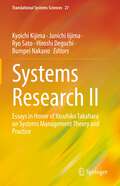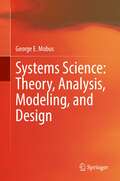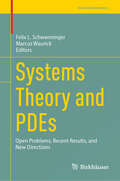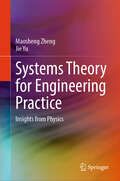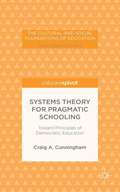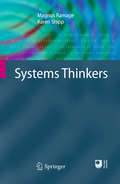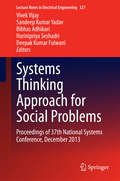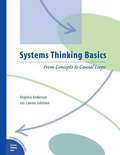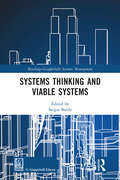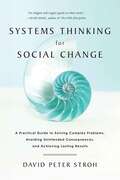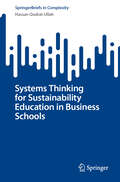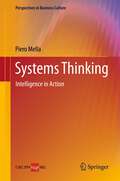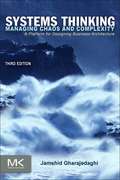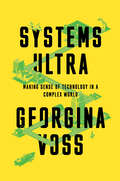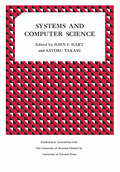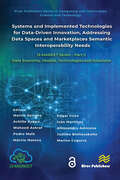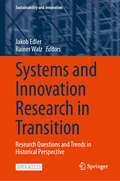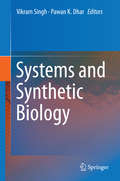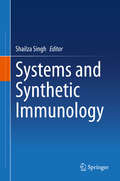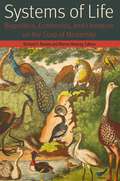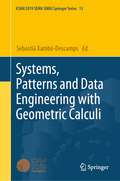- Table View
- List View
Systems Research II: Essays in Honor of Yasuhiko Takahara on Systems Management Theory and Practice (Translational Systems Sciences #27)
by Kyoichi Kijima Hiroshi Deguchi Ryo Sato Junichi Iijima Bumpei NakanoThis book is in honor of Yasuhiko Takahara, a first-class researcher who has been active for some 50 years at the global level in systems research. Researchers and practitioners from Japan and other countries who have been influenced by Takahara have come together from far and wide to contribute their major research masterpieces in the field of systems research in the broadest sense.While the roots of Takahara’s systems research are in general systems theory and systems control theory, he developed his research and teaching in diverse directions such as management information science, engineering, social simulation, and systems thinking. As a result, many of the researchers and practitioners he supervised or influenced have established their own positions and are now active around the world in a wide range of systems research.Volume II is a collection of their masterpieces or representative works in the fields of systems management theory and practice.
Systems Science Level 4
by Cheryl Chiapperino Macki Jones Sheri Leasure Lisa WoodA science book set for Christian educators and schools worldwide. Topics covered include: life science: stability, physical sciences, earth & space: balance and human body wellness.
Systems Science: Theory, Analysis, Modeling, and Design
by George E. MobusThis book describes a comprehensive approach to applying systems science formally to the deep analysis of a wide variety of complex systems. Detailed ‘how-to’ examples of the three phases (analysis-modeling-design) of systems science are applied to systems of various types (machines, organic (e.g. ecosystem), and supra-organic (e.g. business organizations and government). The complexity of the global system has reached proportions that seriously challenge our abilities to understand the consequences of our use of technology, modification of natural ecosystems, or even how to govern ourselves. For this reason, complex mathematics is eschewed when simpler structures will suffice, allowing the widest possible audience to apply and benefit from the available tools and concepts of systems science in their own work. The book shows, in detail, how to functionally and structurally deconstruct complex systems using a fundamental language of systems. It shows how to capture the discovered details in a structured knowledge base from which abstract models can be derived for simulation. The knowledge base is also shown to be a basis for generating system design specifications for human-built artifacts, or policy recommendations/policy mechanisms for socio-economic-ecological systems management. The book builds on principles and methods found in the authors’ textbook Principles of Systems Science (co-authored with Michael Kalton), but without prerequisites. It will appeal to a broad audience that deals with complex systems every day, from design engineers to economic and ecological systems managers and policymakers.
Systems Theory and PDEs: Open Problems, Recent Results, and New Directions (Trends in Mathematics)
by Marcus Waurick Felix L. SchwenningerThis volume presents recent advances and open problems in the cross section of infinite-dimensional systems theory and the modern treatment of PDEs. Chapters are based on talks and problem sessions from the first “Workshop on Systems Theory and PDEs” (WOSTAP), held at TU Bergakademie Freiberg in July 2022. The main topics covered include: Differential algebraic equations Port-Hamiltonian systems in both finite and infinite dimensions Highly nonlinear equations related to elasticity/plasticity Modeling of thermo-piezo-electromagnetism
Systems Theory for Engineering Practice: Insights from Physics
by Jie Yu Maosheng ZhengThis book presents cognition of the universality of systems theory thinking by using some ordinary physical phenomena and their methods in study, of which the involved treatments are consistent with the viewpoint of systems theory. It contains the collective actions of classical vibration of many bodies and wave, the extreme value problem in natural world, status of electrons in atom-molecule and metals, Ising model in phase transition and elementary excitation in solid, multi-objective optimization in a system, description of effective media approximation, certainty in uncertain phenomena, all these reflect the cooperative/synergetic effects, wholeness of group actions, “unity of opposites” inside a system, and collective phenomena in a system completely. The relevant methodologies for systems theory are organic combination and synergism of both “reductionism” and “holism” instead of “confrontation” or “separation” of them, which could be used in dealing with analogous problems in systems science and engineering fields in response to the idiom of “stones from other hills being good for polishing this jade” and “comprehend by analogy”, so as to promote the transformation of wisdom to productivity. The authors wish this work could play its role as a paving stone to serve the research and application of systems theory. This book can be used as a textbook for postgraduate and advanced undergraduate students in relevant majors, and a reference book for scientists and practitioners in related fields.
Systems Theory for Pragmatic Schooling: Toward Principles of Democratic Education
by Craig A. CunninghamWriting for educators and education leaders, Cunningham shows that combining a philosophy of pragmatism with thinking about education as systems can illuminate challenges in contemporary schooling and provide practical solutions for creating a democratic education.
Systems Thinkers
by Karen Shipp Magnus RamageThis book presents a biographical history of the field of systems thinking, by examining the life and work of thirty of its major thinkers. It discusses each thinker's key contributions, the way this contribution was expressed in practice and the relationship between their life and ideas. This discussion is supported by an extract from the thinker's own writing, to give a flavour of their work and to give readers a sense of which thinkers are most relevant to their own interests.
Systems Thinking Approach for Social Problems
by Vivek Vijay Sandeep Kumar Yadav Bibhas Adhikari Harinipriya Seshadri Deepak Kumar FulwaniThe book is a collection of peer-reviewed scientific papers submitted by active researchers in the 37th National System Conference (NSC 2013). NSC is an annual event of the Systems Society of India (SSI), primarily oriented to strengthen the systems movement and its applications for the welfare of humanity. A galaxy of academicians, professionals, scientists, statesman and researchers from different parts of the country and abroad are invited to attend the conference. The book presents research articles in the areas of system's modelling, complex network modelling, cyber security, sustainable systems design, health care systems, socio-economic systems, and clean and green technologies. The book can be used as a tool for further research.
Systems Thinking Basics: From Concepts to Causal Loops
by Virginia Anderson Lauren Johnson<p>Systems Thinking Basics is a self-study, skill-building resource designed to introduce you to the power of systems thinking tools. With an emphasis on behavior over time graphs and causal loop diagrams, this workbook guides you step by step through: Recognizing systems and understanding the importance of systems thinking; Interpreting and creating behavior over time graphs and causal loop diagrams; Applying and practicing systems thinking day-to-day. <p>Each of the book's six main sections contains a wealth of examples from the business world, as well as learning activities that reinforce concepts and provide you with the opportunity and space to practice. An array of appendices offers: Extra practice activities; A summary of key points and suggested responses to the learning activities; A table showing the "palette" of systems thinking tools available; A glossary of systems thinking terms; A list of additional resources; A summary of the systems archetypes. <p>The many diagrams within the book clarify concepts and visually reinforce key principles. Systems Thinking Basics is ideal for aspiring systems thinkers eager to try their hand at using these powerful tools</p>
Systems Thinking and Viable Systems (Routledge-Giappichelli Systems Management)
by Sergio BarileIn the last few decades, managerial and business studies have shown an increasing inability to explain and forecast emergent dynamics in society, economics, and the environment.Consolidated managerial approaches and business theories seem to be incapable of communicating and depicting the ongoing evolution, and new perspectives are required to support both researchers and practitioners in tracing new paths for development. Building upon the constructivist approach, this book illustrates the multiple advantages that systems thinking can offer in supporting a holistic understanding of social and economic phenomena.The book proposes a representation of the firm as a viable system and represents its functioning and decision-making processes trough a recursive depiction that can be applied for each of the multiple levels through which socio-economic environments are defined. As a result of the focus on the differences between decision making and problem-solving processes, the book enriches current knowledge about systems thinking and provides useful instruments through which both researchers and practitioners can effectively understand the multiple variables able to influence decisions and actions within a firm’s configuration.The book is aimed at both postgraduate students and researchers interested in the multiple dimensions of systems thinking.
Systems Thinking for Social Change: A Practical Guide to Solving Complex Problems, Avoiding Unintended Consequences, and Achieving Lasting Results
by David Peter StrohConcrete guidance on how to incorporate systems thinking in problem solving, decision making, and strategic planning―for everyone! <p><p>Donors, leaders of nonprofits, and public policy makers usually have the best of intentions to serve society and improve social conditions. But often their solutions fall far short of what they want to accomplish and what is truly needed. Moreover, the answers they propose and fund often produce the opposite of what they want over time. We end up with temporary shelters that increase homelessness, drug busts that increase drug-related crime, or food aid that increases starvation. <P><P>How do these unintended consequences come about and how can we avoid them? By applying conventional thinking to complex social problems, we often perpetuate the very problems we try so hard to solve, but it is possible to think differently, and get different results. <P><P>Systems Thinking for Social Change enables readers to contribute more effectively to society by helping them understand what systems thinking is and why it is so important in their work. It also gives concrete guidance on how to incorporate systems thinking in problem solving, decision making, and strategic planning without becoming a technical expert.
Systems Thinking for Sustainability Education in Business Schools (SpringerBriefs in Complexity)
by Hassan Qudrat-UllahThis book delves into the current state and future prospects of systems thinking and sustainability education within business schools. It meticulously examines the trends and drivers shaping the demand and supply of such education, along with the implications and challenges it presents for various stakeholders and society at large. Strategic recommendations and suggestions are provided to elevate and propel systems thinking and sustainability education in business schools, outlining a visionary roadmap for the future. Furthermore, the book explores the intersectionality of sustainability and diversity in business education, offering examples and cases of visionary and innovative initiatives and projects in the field. Distinguished by special features such as illustrations, the book offers a comprehensive and integrative overview of the current landscape and future trajectories of systems thinking and sustainability education in business schools. The primary benefit for readers lies in gaining a deeper and broader understanding of systems thinking and sustainability education in business schools. It equips them with the knowledge to apply systems thinking and sustainability principles and tools to tackle the complex and wicked problems of the twenty-first century. Additionally, the book aims to inspire and inform business schools and their stakeholders to embrace and enhance systems thinking and sustainability education in their curricula and pedagogy, contributing to the advancement of sustainability and systems thinking in both business and society.
Systems Thinking: From Heresy to Practice
by Keivan Zokaei John Seddon Brendan O'DonovanSystems Thinking is a topic which is at the forefront of how we think about management in the Public Sector and Service Industries. This collection from leading thinkers in the field takes a case study approach to a variety of issueswhich encompass topics such as Banking, Electrical Distribution, Manufacturing andAdult Social Care. "
Systems Thinking: Intelligence in Action
by Piero MellaThe core belief underlying this book is that the most useful and effective models to strengthen our intelligence are system ones, developed following the logic of Systems Thinking. Such models can explore complexity, dynamics, and change, and it is the author's view that intelligence depends on the ability to construct models of this nature. The book is designed to allow the reader not only to acquire simple information on Systems Thinking but above all to gradually learn the logic and techniques that make this way of thinking an instrument for the improvement of intelligence. In order to aid the learning and practice of the Systems Thinking discipline, the author has abandoned a rigid formal language for a more discursive style. He writes in the first person, with an ample number of citations and critical analyses, and without ever giving in to the temptation to use formal mathematics.
Systems Thinking: Managing Chaos And Complexity: A Platform For Designing Business Architecture
by Jamshid GharajedaghiSystems Thinking, Third Edition combines systems theory and interactive design to provide an operational methodology for defining problems and designing solutions in an environment increasingly characterized by chaos and complexity. This new edition has been updated to include all new chapters on self-organizing systems as well as holistic, operational, and design thinking. <p><p> The book covers recent crises in financial systems and job markets, the housing bubble, and environment, assessing their impact on systems thinking. A companion website is available at interactdesign.com. <p> This volume is ideal for senior executives as well as for chief information/operating officers and other executives charged with systems management and process improvement. It may also be a helpful resource for IT/MBA students and academics.
Systems Ultra: Making Sense of Technology in a Complex World
by Georgina VossA TOOLBOX FOR COMPREHENDING — AND CHANGING — THE WORLDSystems Ultra explores how we experience complex systems: the mesh of things, people, and ideas interacting to produce their own patterns and behaviours.What does it mean when a car which runs on code drives dangerously? What does massmarket graphics software tell us about the workplace politics of architects? And, in these human-made systems, which phenomena are designed, and which are emergent? In a world of networked technologies, global supply chains, and supranational regulations, there are growing calls for a new kind of literacy around systems and their ramifications. At the same time, we are often told these systems are impossible to fully comprehend and are far beyond our control.Drawing on field research and artistic practice around the industrial settings of ports, air traffic control, architectural software, payment platforms in adult entertainment, and car crash testing, Georgina Voss argues that complex systems can be approached as sites of revelation around scale, time, materiality, deviance, and breakages. With humour and guile, she tells the story of what &‘systems&’ have come to mean, how they have been sold to us, and the real-world consequences of the power that flows through them.Systems Ultra goes beyond narratives of technological exceptionalism to explore how we experience the complex systems which influence our lives, how to understand them more clearly, and, perhaps, how to change them.
Systems and Computer Science: Proceedings of a Conference held at the University of Western Ontario September 10-11, 1965
by John Hart Satoru TakasuThis book presents the papers delivered at the Conference on Systems and Computer Science held at the University of Western Ontario in September 1965. The primary purposes of the Conference were the promotion of research and the development of the teaching of computer science in Canadian universities. The papers focus attention on some of the concepts of Computer Science as a new field of study and at the same time provide a background for scientists looking at the subject for the first time. The chief developments in computer science have been concerned with the "applied" rather than the "pure" areas of the field: numerical analysis, applied statistics and operations research, and data processing. But there is something more to computers than the physical components and this book represents an attempt to correct the imbalance between "applied" and "pure" by drawing attention to certain theoretical aspects of computer and information science. Among the topics discussed are the theory of finite and infinite automata, aspects of formal language theory, heuristic and non-heuristic approaches to theorem proving and the mathematical formulation of the theory of general systems. There are also references to the problems of machine design, to software systems including higher-level languages, to multiple control computer models and to applied systems. This collection of papers will appeal first to graduate students and professors in Computer Science. It will also be of interest to computer scientists in industry and in government and university research groups and to the scientific public interested in discovering some of the principal ingredients and directions of the computer and information sciences.
Systems and Implemented Technologies for Data-Driven Innovation, addressing Data Spaces and Marketplaces Semantic Interoperability Needs: i3-MARKET Series - Part II: Data Economy, Models, Technologies and Solutions (River Publishers Series in Computing and Information Science and Technology)
by Martín Serrano Achille Zappa Waheed Ashraf Pedro Maló Márcio Mateus Edgar Fries Iván Martínez Alessandro Amicone Justina Bieliauskaite Marina CugurraIn the second i3-MARKET series book we review the basic technological principles, software best practices, and standards for implementing and deploying data spaces and data marketplaces. The book provides a definition for data-driven society as: The process to transform data production into data economy for the people using the emerging technologies and scientific advances in data science to underpin the delivery of data economic models and services. This book further discusses why data spaces and data marketplaces are the focus in today’s data-driven society as the trend to rapidly transform the data perception in every aspect of our activities. In this book, technology assets that are designed and implemented following the i3-MARKET backplane reference implementation (WebRI) that uses open data, big data, IoT and AI design principles is introduced. Moreover, the series of software assets grouped as sub-systems and composed by software artefacts are included and explained in full. Further, we describe i3-MARKET backplane tools and how these can be used for supporting marketplaces and its components including details of available data assets. Next, we provide descriptions of solutions developed in i3-MARKET as an overview of the potential for being the reference open-source solution to improve data economy across different data marketplaces.
Systems and Innovation Research in Transition: Research Questions and Trends in Historical Perspective (Sustainability and Innovation)
by Rainer Walz Jakob EdlerIn the last decades it has become more and more imperative for our societies, and for decision makers in all areas of society, to understand the dynamics through which innovation systems develop and through which socio-technical systems transform themselves. As both innovation and transformation are strongly intertwined, it has equally become imperative to analyse their dynamics as well as their interplay. This open access volume reflects on the research fields that have developed in the last five decades to do exactly that. It defines and delineates research on systems and innovation as encompassing the scientific study of, first, the conditions, dynamics and impacts associated with the generation and uptake of innovations and, second, the development and transformation of functional systems satisfying essential needs such as the provision of energy or water. Further, the area of Systems and Innovation Research (SIR) is characterised by problem and stakeholder oriented research. We chose five decades as time frame because we noted that roughly 50 years ago a number of research institutes dedicated to SIR were founded and the SIR area started to grow significantly. We present a systematic history of nine selected fields within the area of SIR (Innovation policy, Innovation indicators, Foresight, Policy Evaluation, Technology Assessment, Production Paradigms, Renewable Energies, Energy Efficiency, Water Use). We also present a conceptual framework to understand the processes by which the research fields have developed. This allows to draw general lessons as to what drives fields throughout their development and how their role vis-à-vis policy, businesses and societies changes over time. It also allows to speculate about future challenges and trends in the SIR area. This is important because, if anything, the need to govern transformation through innovation will further grow in the future, and with it the need to understand the underlying dynamics.
Systems and Synthetic Biology
by Vikram Singh Pawan K. DharThis textbook has been conceptualized to provide a detailed description of the various aspects of Systems and Synthetic Biology, keeping the requirements of M. Sc. and Ph. D. students in mind. Also, it is hoped that this book will mentor young scientists who are willing to contribute to this area but do not know from where to begin. The book has been divided into two sections. The first section will deal with systems biology - in terms of the foundational understanding, highlighting issues in biological complexity, methods of analysis and various aspects of modelling. The second section deals with the engineering concepts, design strategies of the biological systems ranging from simple DNA/RNA fragments, switches and oscillators, molecular pathways to a complete synthetic cell will be described. Finally, the book will offer expert opinions in legal, safety, security and social issues to present a well-balanced information both for students and scientists.
Systems and Synthetic Immunology
by Shailza SinghSystems and Synthetic Immunology focuses on the similarities between biology and engineering at the systems level, which are important for applying engineering theories to biology problems. With the advent of new genomic techniques, there are numerous systematic investigations underway in the scientific world. This volume highlights techniques that can be used to effectively combine two of the most essential biological fields - Systems Biology and Synthetic Immunology.The respective chapters discuss the role of synthetic immunology in biotechnology, production of biomaterials, and their use in vaccine delivery. Further topics include the importance of cytokines; the use of genomic engineering tools in immunotherapy; immunosensors; nanotherapeutics; and bioinformatics tools in biomedical applications. Given its scope, the book offers readers an up-to-date and comprehensive review of this unique and dynamic field of research.
Systems of Life: Biopolitics, Economics, and Literature on the Cusp of Modernity (Forms of Living)
by Richard A. Barney and Warren MontagSystems of Life offers a wide-ranging revaluation of the emergence of biopolitics in Europe from the mid– eighteenth to the mid–nineteenth century. In staging an encounter among literature, political economy, and the still emergent sciences of life in that historical moment, the essays collected here reopen the question of how concepts of animal, vegetable, and human life, among other biological registers, had an impact on the Enlightenment project of thinking politics and economics as a joint enterprise. The volume’s contributors consider politics, economics, and the biological as distinct, semi-autonomous spheres whose various combinations required inventive, sometimes incomplete, acts of conceptual mediation, philosophical negotiation, disciplinary intervention, or aesthetic representation.
Systems, Patterns and Data Engineering with Geometric Calculi (SEMA SIMAI Springer Series #13)
by Sebastià Xambó-DescampsThe intention of this collection agrees with the purposes of the homonymous mini-symposium (MS) at ICIAM-2019, which were to overview the essentials of geometric calculus (GC) formalism, to report on state-of-the-art applications showcasing its advantages and to explore the bearing of GC in novel approaches to deep learning. The first three contributions, which correspond to lectures at the MS, offer perspectives on recent advances in the application GC in the areas of robotics, molecular geometry, and medical imaging. The next three, especially invited, hone the expressiveness of GC in orientation measurements under different metrics, the treatment of contact elements, and the investigation of efficient computational methodologies. The last two, which also correspond to lectures at the MS, deal with two aspects of deep learning: a presentation of a concrete quaternionic convolutional neural network layer for image classification that features contrast invariance and a general overview of automatic learning aimed at steering the development of neural networks whose units process elements of a suitable algebra, such as a geometric algebra. The book fits, broadly speaking, within the realm of mathematical engineering, and consequently, it is intended for a wide spectrum of research profiles. In particular, it should bring inspiration and guidance to those looking for materials and problems that bridge GC with applications of great current interest, including the auspicious field of GC-based deep neural networks.
Systems-Level Modelling of Microbial Communities: Theory and Practice (Focus Computational Biology Series)
by Karthik Raman Aarthi RavikrishnanSystems-Level Modelling of Microbial Communities: Theory and Practice introduces various aspects of modelling microbial communities and presents a detailed overview of the computational methods which have been developed in this area. This book is aimed at researchers in the field of computational/systems biology as well as biologists/experimentalists studying microbial communities, who are keen on embracing the concepts of computational modelling. The primary focus of this book is on methods for modelling interactions between micro-organisms in a community, with special emphasis on constraint-based and network-based modelling techniques. A brief overview of population- and agent-based modelling is also presented. Lastly, it covers the experimental methods to understand microbial communities, and provides an outlook on how the field may evolve in the coming years.
Systemverfahrenstechnik in der Ingenieurspraxis: Beherrschung von Prozessen, Gefährdungen und Reinheitskriterien
by Bernd EbertDas Buch behandelt die für das Optimum verfahrenstechnischer Prozesse unerlässliche System-Betrachtung. Diese sollte nicht nur für den „reinen“ Prozess erfolgen, sondern für den gesamten Lebenszyklus technischer Anlagen – vom Entwurf eines Prozesses bis zur Optimierung im laufenden Betrieb. Dabei kommt es nicht nur auf den Normalbetrieb an (wie häufig bei Simulationen betrachtet), sondern auch auf An- und Abfahrprozesse, das Havarie-/Störungsverhalten der Prozesse, die Reinigungsabläufe, Sicherheitsmaßnahmen usw. Geeignete Analyse- und Betrachtungsmethoden werden dazu vorgestellt, die sich in langjähriger Planungs- und Betriebspraxis herausgebildet haben. Hierzu zählen u.a. Risikoanalysen, Zeitdynamik- und Zuverlässigkeitsmethoden; deren theoretischer Ansatz wird mit ihrer praktischen Anwendbarkeit verbunden. Auch Aspekte wie Industrie 4.0 und Prozessänderungen bei laufenden Anlagen werden betrachtet. Damit soll ein Beitrag sowohl für die Ingenieurausbildung, die technische Betriebsbetreuung als auch für die Projektabwicklung geleistet werden.
